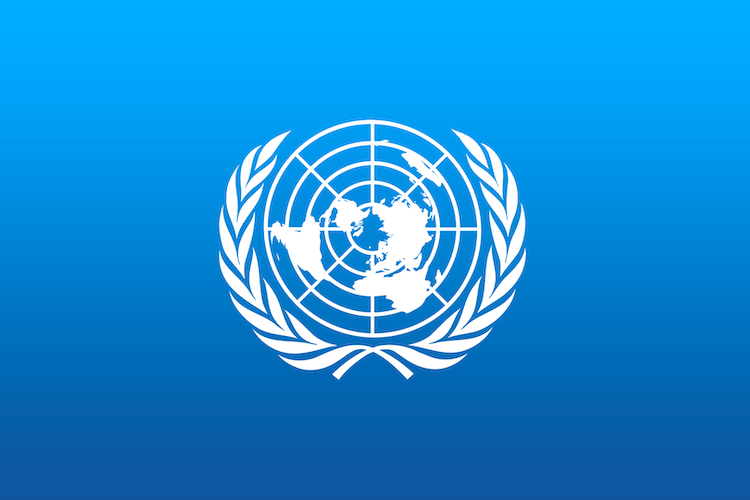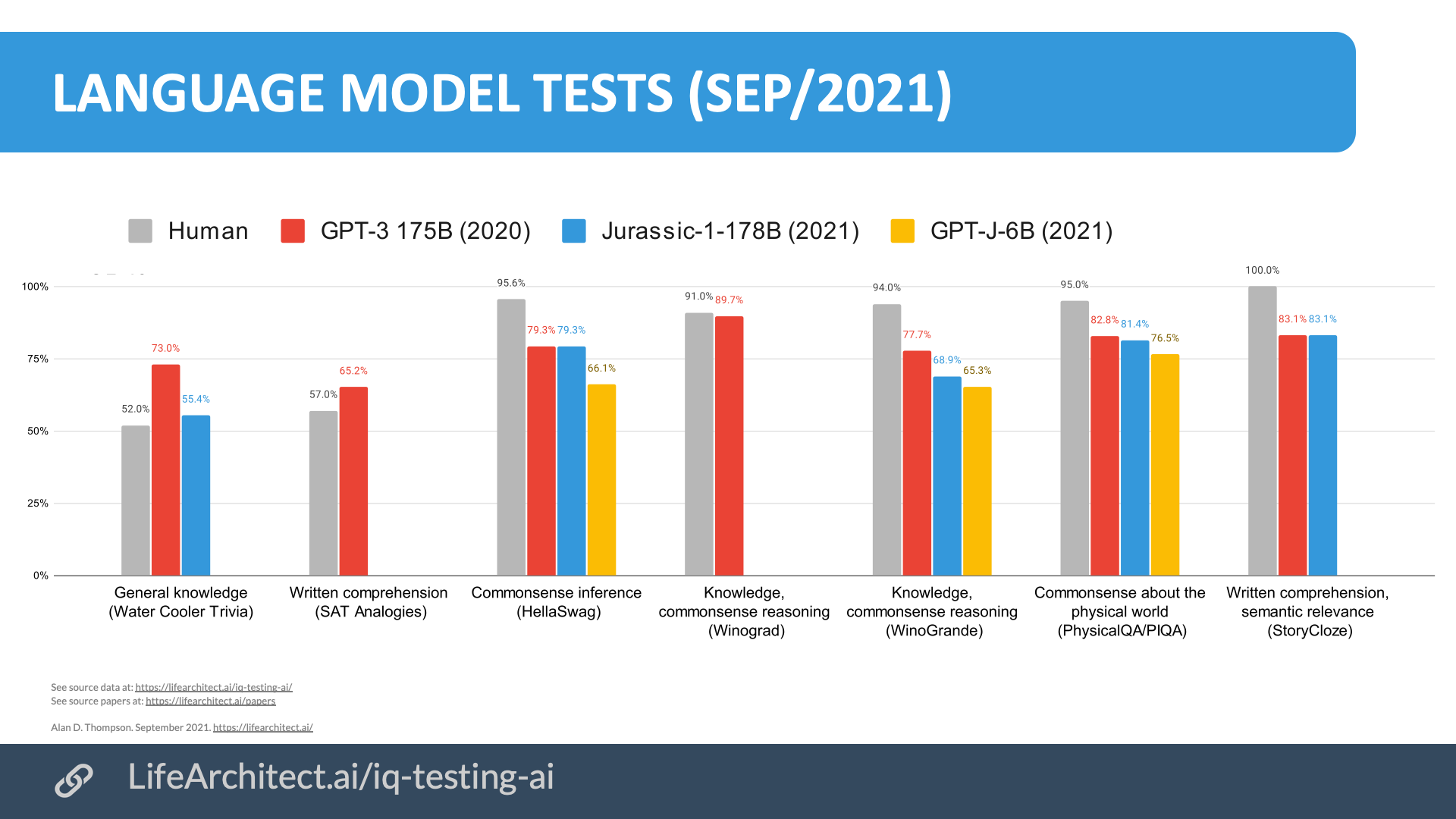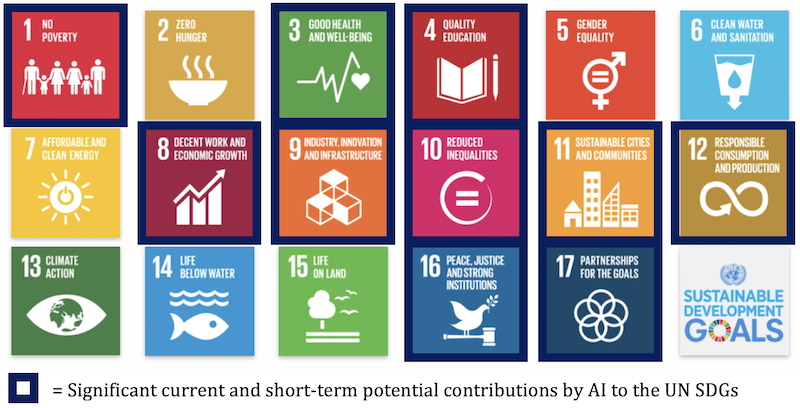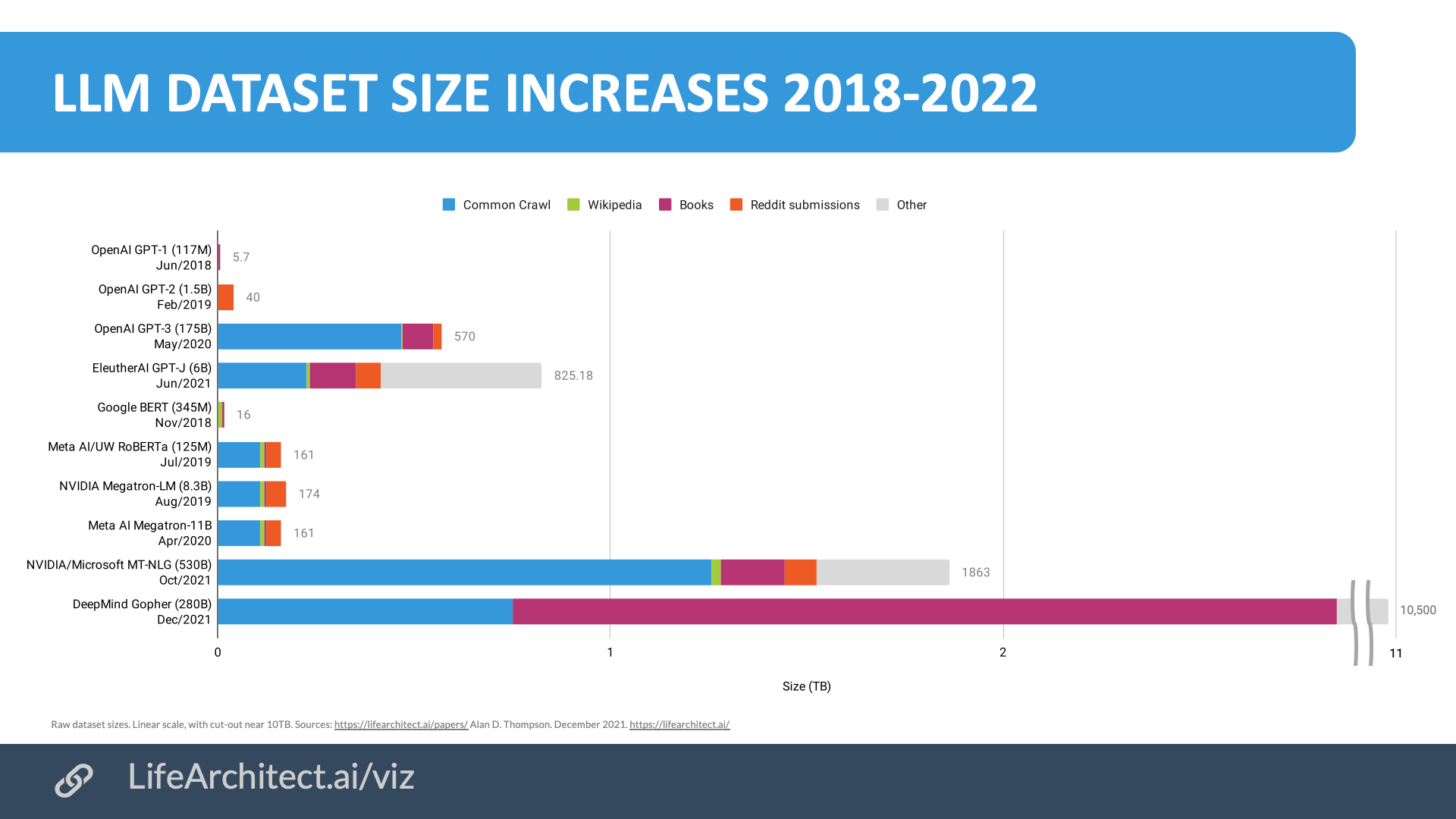Title: Artificial intelligence is advancing the achievement of the UN SDGs
Authors: Alan D. Thompson (LifeArchitect.ai), Anuraj Gambhir (Wise/White Mirror)
Submitted: January 2022
Abstract
Artificial intelligence (AI) has grown exponentially since the pivotal discovery of enabling technologies in the subfield of large language models in 2017. The impacts of AI are already being felt across all functions of society, economy, and business. For AI to continue to play a beneficial role at all levels in the future, it is important to align AI developments that enable the UN Sustainable Development Goals (SDGs), and to encourage the acceleration of AI technology. Derived from independent research findings, this high-level paper considers key recommendations on future policy developments.
Introduction
In 2015, 193 countries agreed to the United Nations (UN) 2030 Agenda for Sustainable Development, which provides a shared blueprint for peace and prosperity for all humanity. At its heart are the Sustainable Development Goals (SDGs), a collection of 17 interlinked global goals designed as a framework of recommendations and principles to achieve a better and more sustainable future for all. The SDGs are an urgent call for action by all countries— developed and developing—in a global partnership. The SDGs are intended to be achieved by the year 2030. Achieving the SDGs is not just a moral imperative, but a universal one.
In 2022, the world is experiencing the rapid evolution of artificial intelligence (AI). The technology approach has been defined as one that allows “machines to perform human-like cognitive functions such as reasoning and learning” (Sadowski & Powell-Tuc, 2019). AI supplements and amplifies our human biological intelligence, exponentially multiplying the capacity of all human beings to understand and solve complex, dynamic, and interconnected systemic challenges like the SDGs.
The explosive progress of AI and its increasingly broad adoption is comparable to the rapid dissemination of the internet in the 1990s and smart phones in the 2000s.
Over the next few years, AI will continue to have an impact on our lives that is—according to Google/Alphabet CEO Sundar Pichai—more profound than fire, electricity, or the internet (Rajan, 2021). The latest language models are achieving unprecedented and outrageous outcomes: powering Google searches, writing up to 30% of all new computer code in 2021 (Walsh, 2021), writing articles for major media outlets including The Guardian and The New York Times (GPT-3, 2020; Metz, 2020), publishing books (Thompson, 2021a), outperforming humans in SAT questions (Thompson, 2021b), and significantly surpassing the televised performance of the 2011 version of IBM Watson (Thompson, 2021c).
Figure 1. Human intelligence versus AI (selected large language models) 2020–2021
AI & SDGs
The SDGs are inherently a complex, systemic challenge that require collaboration across disciplines (ethics, innovation, justice…), sectors (private, national government, multigovernmental…), and fields (education, finance, logistics…) to realize and resolve.
As promising and beneficial as AI is, its development and release also comes with its own systemic and social challenges. All progress needs to be reconsidered in the light of the important ethical conundrums raised using AI to achieve the SDGs. Our objective is to identify, define, analyze, and disentangle the various impacts that AI’s development may generate in relation to the SDGs.
Figure 2: Artificial intelligence and the UN SDGs. Significant contributions by AI highlighted
To do so, it is necessary to combine the experience of the artificial intelligence community with the expertise of multidisciplinary specialists across fields such as neuroscience, economics, education, sociology, law, design, and many more.
The current generation of language models and multimodal models (mapping relationships between images, text, and more) up to 2022 are the latest frontier in artificial intelligence. Through training of language models with large-scale datasets and subsequent deployment of inference, this generation of AI offers a broad capacity to support the achievement of the SDGs.
Given that such models are trained on human-generated data from books, journal articles, and web content, the models can be regarded as a universal extension of human biological intelligence.
Figure 3: Increasing dataset sizes for major large language models 2018–2021.
Various large organizations—including Salesforce, Duolingo, Intel, and Disney (OpenAI, 2021a)—have applied artificial intelligence to accelerate discoveries, with the added benefit of exponential increases in efficiency and productivity. Indeed, while a single 2020 language model continues to output 3.1 million words per minute (OpenAI, 2021b), 2021 saw many new models released by competing organizations internationally, leveraging the same technology (Thompson, 2021d), and paving the way for major developments across fields directly impacting the achievement of the SDGs.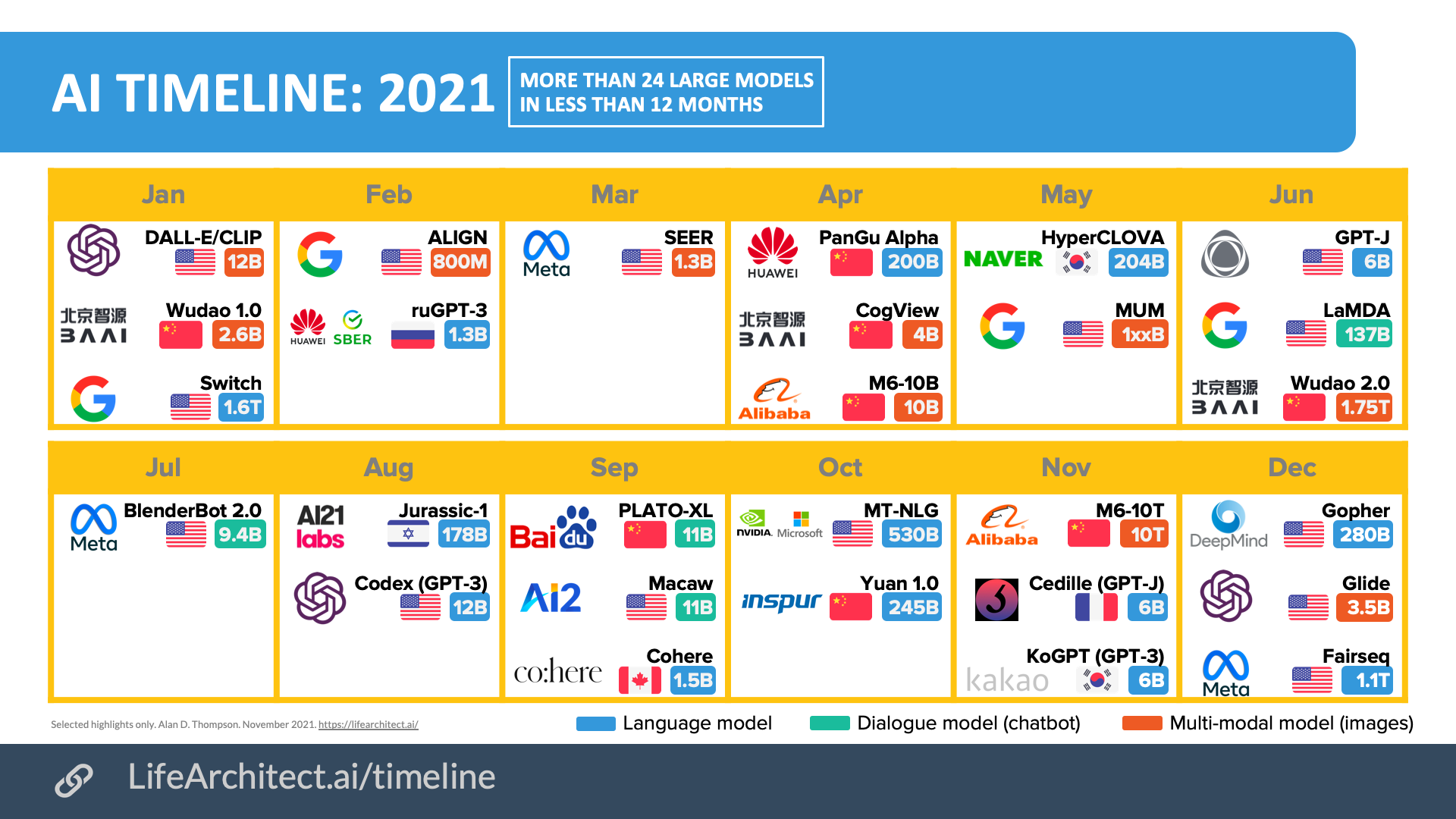
Figure 4: AI timeline of language model releases in 2021
For example, large language models are enabling new teaching and learning methods, and providing new pathways for pedagogy to improve the quality of personalized and transdisciplinary education. This may include the integration of AI with biological intelligence, alleviating the need for traditional education in its current form. Having an educated and informed population is a key driver for multiple SDGs including innovation, economic growth, and peace.
In the health and wellbeing field, antibiotic research and discovery requires massive amounts of experiments and processes. Artificial intelligence has been used to automate repetitive and time-consuming research, identifying a powerful new drug called Halicin (Trafton, 2020). Similarly in the computing hardware field, Google applied AI to chip floorplanning for its latest generation of TPU chips (Nature, 2021).
But artificial intelligence may also impede progress towards the SDGs. First, they can be abused and involved in major ethical issues including spam and false information.
Additionally, the proliferation of artificial intelligence across industries is causing cognitive job losses. This is primarily affecting workers in lower socioeconomic areas, particularly in regions without the means to invest in such technologies or to educate a workforce able to benefit from this process.
For all 17 SDGs, the authors were able to identify potential positive and negative impacts of AI. A more comprehensive overview is intended to be published at a later date. However, it remains challenging to have a detailed perspective of the different ways AI can impact humanity. A deeper understanding of the opportunities and challenges is required, and this necessitates rapid evaluation and review of technologies on release.
Some researchers believe that AI is showing us the way towards a utopia. Consider Wise/White Mirror’s vision of “WEtopia” (Gambhir, 2020), which addresses SDGs 3, 4, 9, 11, and 17, and is developing a proposal for a new SDG 18, exploring the intersection of exponential technology and spirituality. Humanity has an opportunity to begin developing a wisdom path with scenarios to evolve AI from “augmented intelligence” to an “awakened intelligence” as a roadmap to artificial general intelligence.
In parallel, OpenAI’s original vision for artificial general intelligence is aimed at solving “currently intractable multi-disciplinary problems, including global challenges such as climate change, affordable and high-quality healthcare, and personalized education… [giving humanity] economic freedom to pursue what they find most fulfilling…” (Brockman, 2019).
Others have a more pessimistic view of the future. Nonetheless, it is abundantly clear that the current generation is growing up completely immersed in AI, whether they know it or not. For those of us still discovering the dawning of AI, there will be a period of challenges and struggles in accepting, adopting, and embracing this beneficial technology. To ensure a higher level of acceptance and adoption of AI in society, media visibility and ongoing education on these technologies is crucial.
Selection of opportunities and challenges
This list provides an initial and high-level selection of the current facts and issues, as identified by independent research:
- Opportunity: supplementing. AI is seeing an increasing role in supplementing broad sections of industry, from writing to software development (Walsh, 2021).
- Opportunity: replacing. Where appropriate, AI is contributing to the optimization of complex processes across industries, replacing human activity in time-consuming tasks like legal discovery and report preparation.
- Opportunity: resolving education inequality. AI could leverage important education inequalities, for instance through the democratization of learning by providing universal access to “superintelligence” at low cost.
- Opportunity: prioritizing innovation across urgent challenge areas. AI is being used in creative ways to devise beneficial and impactful innovations, including in fields such as climate science, clean technology, and other urgent challenges.
- Challenge: ethics. Language models sometimes raises critical ethical and social issues (e.g., bias, factuality). This issue is a current focus in the field, and deserves a separate paper.
- Challenge: documentation and contribution. To avoid being an empty promise, AI needs to better document its own impact and challenges, while contributing to achieve SDGs.
- Challenge: low visibility. Despite major AI labs deploying AI at scale to the general public, AI sometimes lacks visibility.
- Challenge: transparency. Current AI discoveries must be made clear by researchers, the media, and related organizations. This clarity includes transparency (i.e. of datasets, training methodology, outcomes, and applications), as well as being easily explainable and understandable (i.e. articulated for the general public, not just for academic researchers).
Key policy recommendations
Derived from our findings, we want to recommend these ideas on future policy development for consideration:
Recommendation 1. Articulation. SDG-related problems must be articulated and phrased so that they may be solved by AI. For example, “no poverty” can be rephrased as an opportunity to achieve equitable wealth distribution.
Recommendation 2. Prioritization. It is highly likely that advanced AI can continue to be used in creative ways to devise beneficial and impactful innovations, including in fields such as climate science, clean technology, and other urgent challenges.
Recommendation 3. Watermarking. Ensure that AI-generated content is clearly marked (or watermarked) in the early stages of AI development. This recommendation may become less relevant as AI is integrated with humanity more completely in the next few years.
Recommendation 4. Equitable distribution. Ensure that the distribution of AI through all regions and socioeconomic groups is broadly equitable.
Recommendation 5. Sub-goals. The United Nations should provide specific sub-goals for artificial intelligence to better translate the 17 SDGs in different fields of practice.
Recommendation 6. Alignment. International guidelines, papers, conferences, and projects should encourage contributors to explain the alignment of their outcomes to the SDGs.
Recommendation 7. Stimulation. Regarding need-driven and context-specific innovation, the United Nations and other governmental and intergovernmental organizations should consider stimulating public–private partnerships.
The opportunities and challenges (threats) presented are necessarily interlaced with peoples’ hopes and fears, particularly due to the proliferation of pessimistic forecasts in media from the last few decades. But artificial intelligence is based on humanity and its documented cognitive outputs: AI is quite literally us. We now have the responsibility and power to call forth awakened intelligence, and to shape our own future.
⬛
Dr Alan D. Thompson is a world expert in artificial intelligence (AI), specializing in the augmentation of human intelligence, and advancing the evolution of ‘integrated AI’. Alan provides AI consulting and advisory to intergovernmental organizations including member states of the European Union, the Commonwealth, and the World Trade Organization. Alan’s applied AI research and visualizations are featured across major international media, including citations in the University of Oxford’s debate on AI Ethics in December 2021. His 2021-2022 experiments with Leta AI and Aurora AI have been viewed over 1,000,000 times.
Updates following Jan/2022 submission:
May/2022: Recommendation 3: OpenAI chose to implement signatures and watermarking in DALL-E 2. Google chose to implement signatures in Imagen.
Nov/2022: Recommendation 3: OpenAI chose to implement watermarking in language models (text) via cryptographic pseudorandom functions.
References, Further Reading, and How to Cite
References
Brockman, B. (2019). Microsoft Invests In and Partners with OpenAI to Support Us Building Beneficial AGI. OpenAI. https://openai.com/blog/microsoft/
Brown, T. B., … & Amodei, D. (2020). Language models are few-shot learners. arXiv preprint. arXiv:2005.14165. https://arxiv.org/abs/2005.14165
Gambhir, A. (2020). About Us: What is White Mirror? https://wisemirror.org/about-us.html
GPT-3 (2020). A robot wrote this entire article. Are you scared yet, human? The Guardian. https://www.theguardian.com/commentisfree/2020/sep/08/robot-wrote-this-article-gpt-3
Metz, C. (2020). Meet GPT-3. It Has Learned to Code (and Blog and Argue). The New York Times. https://www.nytimes.com/2020/11/24/science/artificial-intelligence-ai-gpt3.html
Nature (2021). Google’s AI approach to microchips is welcome — but needs care. Nature. https://www.nature.com/articles/d41586-021-01507-9
OpenAI. (2021a). Build next-gen apps with OpenAI’s powerful models. https://openai.com/api/
OpenAI. (2021b). GPT-3 Powers the Next Generation of Apps. https://openai.com/blog/gpt-3-apps/
Rajan, A. (2021). Google boss Sundar Pichai warns of threats to internet freedom. BBC News. https://www.bbc.com/news/technology-57763382
Sadowski, M., Powell-Tuck, R. (2019). AI & The Sustainable Development Goals: The state of play. 2030Vision. https://www.sustainability.com/thinking/ai-and-the-sustainable-development-goals-the-state-of-play/
Thompson, A. D. (2021a). Books by GPT-3. Life Architect. https://lifearchitect.ai/books-by-ai/
Thompson, A. D. (2021b). AI + IQ testing (human vs GPT-3 vs Jurassic-1). Life Architect. https://lifearchitect.ai/iq-testing-ai/
Thompson, A. D. (2021c). GPT-3 would have easily beaten IBM Watson on Jeopardy! (probably). Life Architect. https://lifearchitect.ai/watson/
Thompson, A. D. (2021d). Timeline of AI and language models. Life Architect. https://lifearchitect.ai/timeline/
Trafton, A. (2020). Artificial intelligence yields new antibiotic. MIT News. https://news.mit.edu/2020/artificial-intelligence-identifies-new-antibiotic-0220
Walsh, B. (2021). GitHub sees uptick in coders using AI assistant. Axios. https://www.axios.com/copilot-artificial-intelligence-coding-github-9a202f40-9af7-4786-9dcb-b678683b360f.html
Acknowledgments
The authors would like to express gratitude to Russ Brown, to the Wise/White Mirror group members (WhiteMirror.live) including Ashok Patel and Peter Storey for their valuable review and contributions, and to Jessica Kelley for final editing and review.
Get The Memo
by Dr Alan D. Thompson · Be inside the lightning-fast AI revolution.Informs research at Apple, Google, Microsoft · Bestseller in 147 countries.
Artificial intelligence that matters, as it happens, in plain English.
Get The Memo.
 Alan D. Thompson is a world expert in artificial intelligence, advising everyone from Apple to the US Government on integrated AI. Throughout Mensa International’s history, both Isaac Asimov and Alan held leadership roles, each exploring the frontier between human and artificial minds. His landmark analysis of post-2020 AI—from his widely-cited Models Table to his regular intelligence briefing The Memo—has shaped how governments and Fortune 500s approach artificial intelligence. With popular tools like the Declaration on AI Consciousness, and the ASI checklist, Alan continues to illuminate humanity’s AI evolution. Technical highlights.
Alan D. Thompson is a world expert in artificial intelligence, advising everyone from Apple to the US Government on integrated AI. Throughout Mensa International’s history, both Isaac Asimov and Alan held leadership roles, each exploring the frontier between human and artificial minds. His landmark analysis of post-2020 AI—from his widely-cited Models Table to his regular intelligence briefing The Memo—has shaped how governments and Fortune 500s approach artificial intelligence. With popular tools like the Declaration on AI Consciousness, and the ASI checklist, Alan continues to illuminate humanity’s AI evolution. Technical highlights.This page last updated: 28/Dec/2022. https://lifearchitect.ai/un/↑
